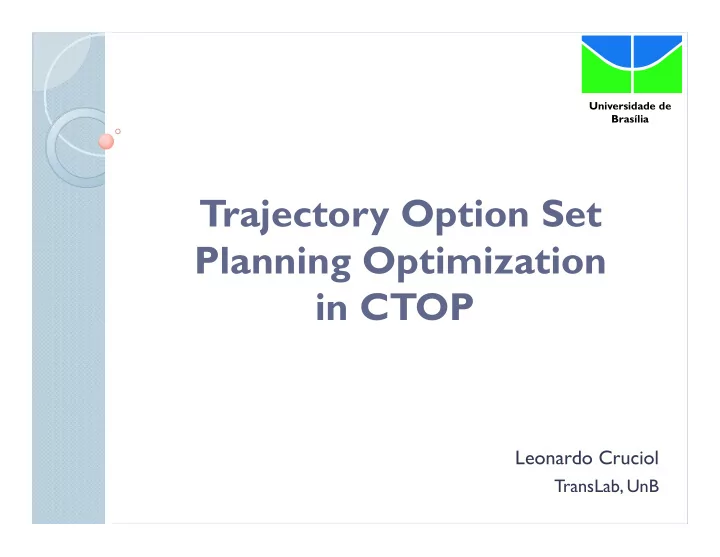

Universidade de Brasília Trajectory Option Set Planning Optimization in CTOP Leonardo Cruciol TransLab, UnB
Outline Collaborative Trajectory Options Programs Delay Reduction in CTOP by TOS Single Game for CTOP (SG-CTOP) SG-CTOP Results Conclusion and future works
Collaborative Trajectory Options Programs CTOP came to improve not only the air traffic fluency but NAS’ users business goals, handle with unknown challenges per flight and achieve better results considering airspace constrains and NAS’ users preferences. In general, CTOP could be summarized as: ◦ Given airspace constraints how achieve a better fluency flow considering capacity, improving business goal results for NAS’ users and make possible to apply reroute and delay together.
CTOP Overview CTOP: 02:00pm to 06:00pm FCA001: 3 slots FCA002: 5 slots Estimated Time of Arrival (FCA001): 02:02pm (ETA-FCA001) Estimated Time of Arrival (FCA002): 02:05pm (ETA-FCA002) Estimated NOSLOT cost: 20 minutes of delay Earliest Initial Arrival Time: 02:02pm at FCA001 (IAT # Flight 2) First available SLOT at FCA001: 02:15pm (13 minutes of delay) First available SLOT at FCA002: 02:10pm (5 minutes of delay)
Delay Reduction in CTOP by TOS Optimization in TOS planning by airlines in CTOP when it happens multiples Flow Constrained Areas (FCA). Expected Results ◦ Dynamic decision support model to plan airlines’ TOS, considering how many trajectories option might be sent for every flight in each CTOP demand and strictly known information by each airline.
Single Game for CTOP (SG-CTOP) B A
SG-CTOP – Cases and Scenarios
Known Estimated Cost by Airline A Estimated delay cost by sending NOSLOT for all its flights. Estimated delay cost by sending one trajectory plus NOSLOT, when Airline B sends NOSLOT option for all its flights. Estimated delay cost by sending two trajectories plus NOSLOT, when Airline B sends NOSLOT option for all its flights.
Single Game for CTOP (SG-CTOP)
SG-CTOP – Known Estimated Delay Matrix Case 1 – Scenario 1 (A = 0, B = 0) Case 1 – Scenario 1 (A = 1, B = 0) Case 1 – Scenario 1 (A = 2, B = 0) Case 1 – Scenario 2 (A = 0, B = 0) Case 1 – Scenario 2 (A = 1, B = 0) Case 1 – Scenario 2 (A = 2, B = 0) Case 1 – Scenario 3 (A = 0, B = 0) Case 1 – Scenario 3 (A = 1, B = 0) Case 1 – Scenario 3 (A = 2, B = 0) Case 2 – Scenario 1 (A = 0, B = 0) Case 2 – Scenario 1 (A = 1, B = 0) Case 2 – Scenario 1 (A = 2, B = 0) Case 2 – Scenario 2 (A = 0, B = 0) Case 2 – Scenario 2 (A = 1, B = 0) Case 2 – Scenario 2 (A = 2, B = 0) Case 2 – Scenario 3 (A = 0, B = 0) Case 2 – Scenario 3 (A = 1, B = 0) Case 2 – Scenario 3 (A = 2, B = 0) Case 3 – Scenario 1 (A = 0, B = 0) Case 3 – Scenario 1 (A = 1, B = 0) Case 3– Scenario 1 (A = 2, B = 0) Case 3 – Scenario 2 (A = 0, B = 0) Case 3 – Scenario 2 (A = 1, B = 0) Case 3– Scenario 2 (A = 2, B = 0) Case 3 – Scenario 3 (A = 0, B = 0) Case 3 – Scenario 3 (A = 1, B = 0) Case 3 – Scenario 3 (A = 2, B = 0)
Case Study 100 different CTOP demands, called as SG-CTOP cycle 100 SG-CTOP cycles was performed CTOP period from 6 to 8 hours FCA capacity of 3 or 5 aircraft per 15 minutes Real data is composed of 331 flights ◦ To New York metropolitan area ◦ From Miami, Dallas, Chicago, San Francisco, Los Angeles and Las Vegas SG-CTOP's payoff value: TOS = 1 or 2
Game Strategies 1. NOSLOT for all flights in every game 2. One trajectory plus NOSLOT option for all flights in every game 3. T wo trajectories plus NOSLOT option for all flights in every game 4. Game move based on SG-CTOP's payoff function
SG-CTOP Results One SG-CTOP Cycle 0 197 140 602 It is possible to verify that SG-CTOP achieved a better, or equal, result in each possible case, from 0% to 14%, after one SG-CTOP cycle of 100 CTOP demands.
SG-CTOP Results Case 1, 2, 3 for 100 SG-CTOP cycles
SG-CTOP Results Case 1 for 100 SG-CTOP cycles
Conclusion After 100 SG-CTOP cycles the best strategy was achieved when it was sent two trajectories option for each FCA plus a NOSLOT option to fly around. This strategy achieved a global delay of 53% less than NOSLOT strategy. When this strategy was compared with the proposed SG-CTOP model, Airline A would achieve a global delay less than this strategy, or equal, in 97% of CTOP negotiations representing an reduction in accumulated delay of 537 hours for Airline A .
Future works Negotiation between airlines as repeated games and an adaptive strategy according to historical competitors' strategy.
Thank You leocruciol@cic.unb.br
Recommend
More recommend